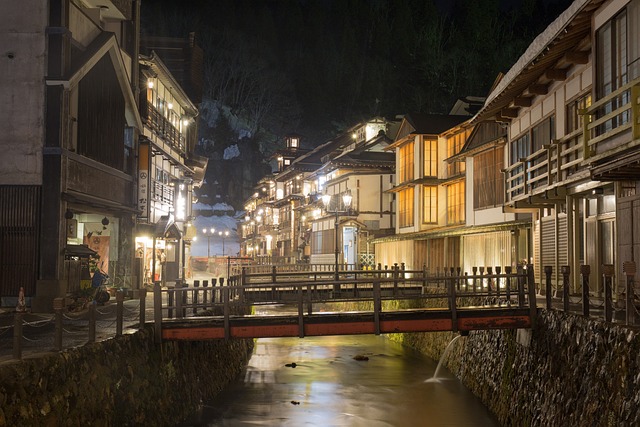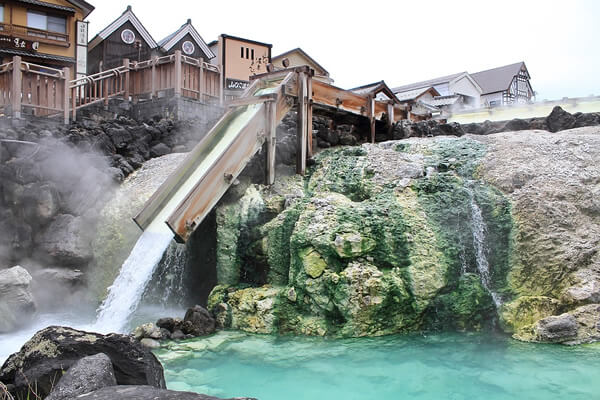The Three Best Hot Spring Resorts in Japan
By Stephen Carr
 |
|
Town of Ryogan, Japan, which is home to a hot spring.
|
Japanese public bathing of men and women
in the nude is a centuries old tradition that largely survived
until the early twentieth century. However, since then such
practices have been discouraged by successive governments.
Today they only survive in remote areas.
However, segregated public bathing is
now the norm over most of Japan and going to a hot spring
resort for rest and relaxation is a popular holiday option.
Japan’s geology provides geothermal
hot spots scattered the length of the land. Although this
puts the islands at constant risk of earthquakes and volcanic
eruptions it also blesses the Japanese with 100 degree farenheit
mineral waters which have been bubbling on or near the land
surface for millennia.
In recent times new technology has been
drawing thermal springs from a kilometer below the earth’s
surface. This has allowed the opening of many new hot springs.
These custom built bath houses have pools of different temperatures,
saunas equipped with televisions, artificial “waterfalls” to
ease aching backs and shoulders, pebble filled reflexology
footbaths, various massage options and air conditioned cooling
off rooms.
But the old places are for the most
part without such fancy facilities. These thermal springs,
which have been spouting for thousands of years, are often
divided into a couple of indoor pools and an outside pool
with changing and cooling off rooms. Resort hotels and spa
towns have grown up around these ancient springs in the
last couple of centuries.
Three very old thermal springs in this
category are by common consent regarded as the best in the
country. They are Kusatsu, Gero and Arima, well patronized
by the Japanese but not especially well known to overseas
visitors.
Kusatsu Thermal Spring
 |
| Hot springs at the Onsen in Kusatsu, Japan. |
The main cultural adjustment for foreigners
visiting hot springs in Japan is not so much minding wandering
around naked in front of strangers than it is observing
a few simple rules, like being sure to soap and rinse the
body before joining the other bathers in the pool. Visitors
have the choice of staying overnight at these spa towns
or sampling them on a day trip. One charming spa feature
is the public hot spring footbaths by the streets where
tired feet can be bathed, free of charge.
Kusatsu, a small town in Gunma prefecture,
is reached via Naganohara Kusatsuguchi, two and a half hours
by train from Tokyo, costing $40. Then there is a twenty
five minute bus ride, about $6.
The town has the distinction of having
the highest output of hot spring water in Japan. Over 11
million gallons a day gush from some 100 springs. They have
been known since the 12th century and have the reputation
of curing almost every illness. The spring water is highly
acidic, giving it good anti-bacterial properties. Its sulphuric
content is also said to be good for beautifying skin.
Kusatsu can also boast of its Yubatake
or “hot water field” in the center of town,
which gushes at 1,100 gallons a minute and 158 degrees farenheit.
Around it is an elaborate wooden channeled cooling system
and several baths.
A unique feature of the place is its
traditional way of cooling the water without adding cold
water. This, it is believed, preserves its medicinal qualities.
Women at the edge of the bath stir the water with five foot
paddles. At the same time they sing. This method, known
as Yumomi, featuring dance movements and colorful costumes
can be seen every day from March 25 to November 30 at the
Netsu no Yu, five minutes from the bus terminal. There are
four performances a day.
There are 18 free public hot spring
baths in this town. The atmosphere among bathers is sociable
since most of the houses do not have their own baths, forcing
the locals to rely on the public ones.
The Sainokawara Open Air Bath is a 500
square yard pool which can hold 100 people. Nestled among
rocks and trees, it has beautiful views of colorful foliage
in the autumn and snow in the winter.
One traditional bathing style, known
as “awase yu” where bathers soak in a set of
tubs, each filled with water of different temperatures,
can be sampled at the Otaki no Yu Onsen.
Places to stay in Kusatsu
The Hotel Boun is
a quiet Japanese inn near the “hot water field.” It
has an outdoor hot spring and a rhododendron garden.
The Kusatsu Hotel with traditional exterior
is at the entrance of Nishinokawara, the main hot spring
source of the town.
The Kusatsu Now Hotel is set high amidst birch and larch forests.
Facilities include spa baths, tennis courts and mini-golf.
The Naraya Hotel is traditional with
tatami matting and futon bedding in the rooms. There are
inside and outside baths and two private ones.
Gero Thermal Spring
Gero is a small town in Gifu prefecture.
The nearest big city is Nagoya, the third largest in Japan
and connected to Tokyo by the Shinkansen or bullet train.
This takes three and a half hours and costs $117. The one
hour and 37 minutes by train trip from Nagoya, via Gifu
and Mino-Ota is very scenic, passing green hillsides, bamboo
groves and mist shrouded rivers. It costs $20.
Gero, which dates its mineral baths
since the tenth century, has a variety of hotels, many with
several hot spring pools on the premises. If you stay at
a hotel its springs are of course open to guests without
extra charge. The room rate often includes breakfast and
dinner.
Day trippers can also bathe in a variety
of spas by buying a Yu-meguri Tegata pass, a wooden amulet
sold all over Gero. It costs $10 and allows the wearer to
try out three spring baths from a list of 20. A stamp is
issued at each one and there is no time restriction on using
the pass.
The whole of Gero can be covered on
foot. Many people walk the streets in yukata cotton robes
and wooden clogs, issued by hotels to their guests.
The town, apart from its rejuvenating
spa waters, is itself of interest. Gassho village is a cluster
of thatched houses, indicating how rural Japanese lived
before the era of concrete. You can go into the houses and
look at old household objects and agricultural implements
as well as trying out traditional crafts like paper making.
There several mini-museums in the complex with stone carved
temple dogs, a parade of moving dolls in festival costumes
and other displays.
Places to Stay in Gero
The Okudaya Hapoen has rooms that all
face the large river, the Hida, that runs through the town
and has a rooftop open air bath with views of the town and
nearby mountains.
The Kikuhan Ryokan Inn, a traditional
wooden structure, is decorated with so many pictures it
looks like an art gallery.
The Suimeikan Hotel is one of the town’s
most venerable with three spas, including an outside one.
Its large rooms have traditional tatami matting and futon
beds. It stages Classic Noh theatre performances.
The Gero Royal Hotel Miyabite has rooms
with individual open air baths.
The Kisoya offers its female
guests baths full of floating English roses.
The Yunoshima-Kan claims it has the
best scenic views from its outside spa.
Arima Onsen Thermal Spring
Arima Onsen is reached from Kobe a 38
minute train ride. Kobe is three hours from
Tokyo by bullet train.
This small quiet town is in a beautiful
location, surrounded by mountains. It is Japan’s oldest
spa, recording a visit there by Japan’s 34th emperor
in the sixth century.
Arima has spring waters of different
colors, red, brown and clear. Kinsen red water gets its
color from its salt and iron content. It has the highest
concentration of salt in Japan and is very hot, coming out
at 200 degrees farenheit. It is mixed with cold water to
allow bathing and the colour is so strong you cannot see
an inch under the water. Ginsen clear water contains carbonic
acid and can be drunk as a stomach purifier.
The town has an all purpose hot spring
area Taikou no Yu, called the Onsen Theme Park which contains
17 hot springs of all kinds to bathe in. Admission is $20
and facilities are of a high standard.
There are two public baths, the Kin-no-yu
which admits adults for $5 and children for $3. The Gin-no-yu
is $4 for adults and $2.50 for children. In addition there
are eight privately run establishments which mostly charge
$8 entry fees.
The Arima craft center illustrates the
history and culture of the town’s hot springs and
stages events and exhibitions. A rest area on the first
floor can be used for a break while walking around town
and entrance to it is free.
Places to Stay in Arima Onsen
The Mint has Western and Japanese style rooms, a spa bath, tennis
court, karaoke and mahjong room.
The Arima Grand Hotel’s has four restaurants and on the ninth floor
a bath of over 2,000 square feet with spectacular views
of Arima.
The Nakanobo Zuien
is in the center of town with gardens and a reservable family
bath as well as an outdoor one. It offers various craft
souvenirs.
Hyoe Koyokaku has a rooftop garden and
three karaoke bars. Meals can be taken in rooms.
The Kinzan is a traditional hotel which
also has some Western style rooms. It has three baths, including
an outside one, offers seasonal food and has a Japanese
garden.
Stephen Carr has
written for newspapers and magazines all over the world.
Since his birth in British East Africa, he has lived in
15 countries. His current home is Japan.
|
